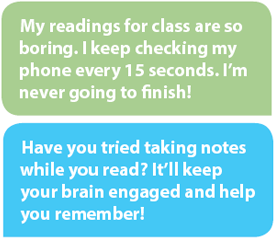Critical reading essentially means reading in such a way as to ensure you truly understand the ideas, arguments and assumptions of the article.
It’s easy to skim over articles and textbook chapters and tell ourselves that we’ve really understood them. But, it’s not until you have to apply that information, on a test for example, that you find out if you’ve really read to understand them.
This lesson will cover three steps: active reading, reading for context, and reading for content.
Active Reading

Active reading means reading with a purpose. Not everything we read will be exciting to us. But sometimes, we just really need to get through it and understand it. One way to do that is to understand why we are reading something, and to work at staying engaged in the reading to achieve that purpose. Tricks like reading with a pencil, noting down key information while we read, and explaining what you’ve read to someone else, are useful.
Reading for Context
In addition to active reading, strong critical readers read for context. Before you even begin reading, you can learn a lot about a work just by considering what it is and where it came from.
The questions in Reading for Context (Reference) can help you to evaluate the context of a source and then make decisions about what kind of information you might be getting, how authoritative that information is, and how relevant it might be to your needs.
| Ask these questions | What will you learn asking these questions? |
|---|---|
| What am I reading? | Always consider the source. What kind of information do you have? A well-researched magazine article or a promotional website? |
| Who is the author? | Investigate the author to understand both their perspective and background on the topic, as well as their authority – are you reading an expert or just someone’s personal opinion? |
| When was it written? | Historical information can be very valuable, but it must be considered in the context of its publication date. |
| Why was it written? | Can you determine the purpose or goal of the work based on the publication source, title, or abstract? |
| Tips | |
| Reliability. Always understand how reliable a source is and never give more value to a source that it deserves.
Authority. Always understand how much the author knows about the topic and what the underlying purpose of goal of a work is. |
|
Practice Reading for Context
Now it’s your chance to practice reading for context. In this lesson, we will practice on Marcus Wohlsen’s 2014 article “Digital Literacy is the Key to the Future, But We Still Don’t Know What It Means,” published in WIRED, an on-line technology journal.
You can view Wohlsen’s article by clicking the citation link below. Answers the questions in the table to assess the context of the article. When you’ve finished, click to open a sample answer.
Reading for Context:
Wohlsen, M. (2016). Digital literacy is the key to the future, but we still don’t know what it means. WIRED. Retrieved 14 April 2016, from http://www.wired.com/2014/09/digital-literacy-key-future-still-don’t-know-means/Wohlsen, M. “Digital Literacy is the Key to the Future.”


Reading for Content
An academic summary demonstrates a strong understanding of the main idea and key points of a source. As we read for content, we can use the context for clues to understanding, and we can focus our attention with active reading skills.
When we read for content, we are looking for three main things:
- The larger topic and focus
- The main idea
- A map of the key points
| Thinking Process | Parts of the Summary: |
|---|---|
|
Describe the basic topic or focus of a work. |
|
Then identify the main idea — what the author has to say about that topic. |
|
And finally list the key points the author offers to develop that main idea. |
Practice Reading for Content
Now, let’s work on reading Wohlsen’s article, focusing on the content.
As you read Wohlsen, answer the questions in the Reading for Content (Practice). Remember to take notes while you’re reading, marking key points or questions. This marking, or annotation, can help you understand the article better.
Wohlsen, M. (2016). Digital literacy is the key to the future, but we still don’t know what it means. WIRED. Retrieved 14 April 2016, from http://www.wired.com/2014/09/digital-literacy-key-future-still-don’t-know-means/Wohlsen, M. “Digital Literacy is the Key to the Future.”

